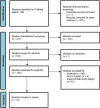Sleep and Temporal Lobe Epilepsy - Associations, Mechanisms and Treatment Implications
- PMID: 35558736
- PMCID: PMC9086778
- DOI: 10.3389/fnhum.2022.849899
Sleep and Temporal Lobe Epilepsy - Associations, Mechanisms and Treatment Implications
Abstract
In this systematic review, we aim to describe the association between temporal lobe epilepsy (TLE) and sleep, with bidirectional links in mechanisms and therapeutic aspects. Sleep stages may variably impact seizure occurrence, secondary generalization and the development, frequency and distribution of interictal epileptiform discharges. Conversely, epilepsy affects sleep micro- and macroarchitecture. TLE, the most frequent form of drug resistant epilepsy (DRE), shares an enduring relationship with sleep, with some intriguing potential mechanisms specific to anatomic localization, linking the two. Sleep characteristics of TLE may also inform localizing properties in persons with DRE, since seizures arising from the temporal lobe seem to be more common during wakefulness, compared to seizures of extratemporal origin. Polysomnographic studies indicate that persons with TLE may experience excessive daytime somnolence, disrupted sleep architecture, increased wake after sleep onset, frequent shifts in sleep stages, lower sleep efficiency, decreased rapid eye movement (REM) sleep, and possibly, increased incidence of sleep apnea. Limited literature suggests that effective epilepsy surgery may remedy many of these objective and subjective sleep-related concerns, via multipronged effects, apart from reduced seizure frequency. Additionally, sleep abnormalities also seem to influence memory, language and cognitive-executive function in both medically controlled and refractory TLE. Another aspect of the relationship pertains to anti-seizure medications (ASMs), which may contribute significantly to sleep characteristics and abnormalities in persons with TLE. Literature focused on specific aspects of TLE and sleep is limited, and heterogeneous. Future investigations are essential to understand the pathogenetic mechanisms linking sleep abnormalities on epilepsy outcomes in the important sub-population of TLE.
Keywords: Epworth sleepiness scale; cognition; mechanisms; polysomnography; refractory epilepsy; sleep; temporal lobe epilepsy.
Copyright © 2022 Garg, Charlesworth and Shukla.
Conflict of interest statement
The authors declare that the research was conducted in the absence of any commercial or financial relationships that could be construed as a potential conflict of interest.
Figures
Similar articles
-
Nocturnal sleep and daytime somnolence in untreated patients with temporal lobe epilepsy: changes after treatment with controlled-release carbamazepine.Epilepsia. 1997 Jun;38(6):696-701. doi: 10.1111/j.1528-1157.1997.tb01239.x. Epilepsia. 1997. PMID: 9186252 Clinical Trial.
-
[Sleep disorders in temporal lobe epilepsy].Arq Neuropsiquiatr. 2003 Dec;61(4):979-87. doi: 10.1590/s0004-282x2003000600017. Epub 2004 Jan 6. Arq Neuropsiquiatr. 2003. PMID: 14762602 Portuguese.
-
NREM Sleep and Antiepileptic Medications Modulate Epileptiform Activity by Altering Cortical Synchrony.Clin EEG Neurosci. 2018 Nov;49(6):417-424. doi: 10.1177/1550059417747436. Epub 2018 Jan 8. Clin EEG Neurosci. 2018. PMID: 29308656
-
Sleep influence on seizures and epilepsy effects on sleep in partial frontal and temporal lobe epilepsies.Clin Neurophysiol. 2000 Sep;111 Suppl 2:S54-9. doi: 10.1016/s1388-2457(00)00402-8. Clin Neurophysiol. 2000. PMID: 10996555 Review.
-
Effects of anti-seizure medications on sleep architecture and daytime sleepiness in patients with epilepsy: A literature review.Sleep Med Rev. 2021 Dec;60:101559. doi: 10.1016/j.smrv.2021.101559. Epub 2021 Oct 8. Sleep Med Rev. 2021. PMID: 34710770 Review.
Cited by
-
Sleep links hippocampal propensity for epileptiform activity to its viscerosensory inputs.Front Neurosci. 2025 Mar 13;19:1559529. doi: 10.3389/fnins.2025.1559529. eCollection 2025. Front Neurosci. 2025. PMID: 40182148 Free PMC article.
-
Longitudinal, EEG-based assessment of sleep in people with epilepsy: An automated sleep staging algorithm non-inferior to human raters.Clin Neurophysiol Pract. 2025 Jan 27;10:30-39. doi: 10.1016/j.cnp.2025.01.001. eCollection 2025. Clin Neurophysiol Pract. 2025. PMID: 39968221 Free PMC article.
-
Mechanistic insights into the interaction between epilepsy and sleep.Nat Rev Neurol. 2025 Apr;21(4):177-192. doi: 10.1038/s41582-025-01064-z. Epub 2025 Mar 10. Nat Rev Neurol. 2025. PMID: 40065066 Review.
-
Case report: Bridging limbic network epilepsy with psychiatric, memory, and sleep comorbidities: case illustrations of reversible psychosis symptoms during continuous, high-frequency ANT-DBS.Front Netw Physiol. 2024 Aug 8;4:1426743. doi: 10.3389/fnetp.2024.1426743. eCollection 2024. Front Netw Physiol. 2024. PMID: 39175607 Free PMC article.
-
The effect of interictal epileptic discharges and following spindles on motor sequence learning in epilepsy patients.Front Neurol. 2022 Nov 10;13:979333. doi: 10.3389/fneur.2022.979333. eCollection 2022. Front Neurol. 2022. PMID: 36438951 Free PMC article.
References
Publication types
LinkOut - more resources
Full Text Sources



